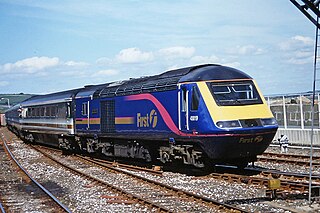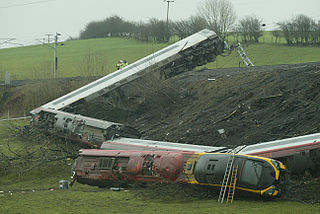
The Ufton Nervet rail crash occurred on 6 November 2004 when a train collided with a stationary car on a level crossing on the Reading–Taunton line near Ufton Nervet, Berkshire, England. The collision derailed the train, and seven people—including the drivers of the train and the car—were killed.
The town of Morpeth in Northumberland, England, has what is reputed to be the tightest curve of any main railway line in Britain. The track turns approximately 98° from a northwesterly to an easterly direction immediately west of Morpeth Station on an otherwise fast section of the East Coast Main Line railway. This was a major factor in three serious derailments between 1969 and 1994. The curve has a permanent speed restriction of 50 miles per hour (80 km/h).

Bexley railway station is in the London Borough of Bexley in south-east London, in Travelcard Zone 6. It is 13 miles 69 chains (22.3 km) down the line from London Charing Cross. The station, and all trains serving it, is operated by Southeastern.
The Norton Fitzwarren rail crash occurred on 4 November 1940 between Taunton and Norton Fitzwarren in the English county of Somerset, when the driver of a train misunderstood the signalling and track layout, causing him to drive the train through a set of points and off the rails at approximately 40mph. 27 people were killed. The locomotive involved was GWR King Class GWR 6028 King Class King George VI which was subsequently repaired and returned to service. A previous significant accident occurred here on 10 November 1890 and the Taunton train fire of 1978 was also within 2 miles.

In Lockington, England on 26 July 1986, the 09:33 passenger train from Bridlington to Kingston upon Hull on the Hull to Scarborough Line struck a passenger van on a level crossing.
The Ealing rail crash was an accident on the British railway system that occurred on 19 December 1973. The 17:18 express train from London Paddington to Oxford—with approximately 650 passengers on board—was derailed while travelling at around 70 mph (110 km/h) between Ealing Broadway and West Ealing. Ten passengers were killed and 94 were injured, and it was Britain's deadliest train crash of the decade until the Moorgate tube crash which killed 45. The cause of the accident was an unsecured maintenance door that had fallen open whilst the train was travelling, after having struck several lineside objects, it struck a Point machine at Longfield Avenue, derailing the entire train.

The Spa Road Junction rail crash was an accident on the British railway system which occurred during the peak evening rush hour of 8 January 1999 at Spa Road Junction in Bermondsey, in South East London.
There have been a number of train accidents on the railway network of Victoria, Australia. Some of these are listed below.
The railways of New South Wales, Australia have had many incidents and accidents since their formation in 1831. There are close to 1000 names associated with rail-related deaths in NSW on the walls of the Australian Railway Monument in Werris Creek. Those killed were all employees of various NSW railways. The details below include deaths of employees and the general public.

The Grayrigg derailment was a fatal railway accident that occurred at approximately 20:15 GMT on 23 February 2007, just to the south of Grayrigg, Cumbria, in the North West England region of the United Kingdom. The accident investigation concluded that the derailment was caused by a faulty set of points on the Down Main running line, controlled from Lambrigg ground frame. The scheduled inspection on 18 February 2007 had not taken place and the faults had gone undetected.

Jarvis plc was a British company that specialised in construction and civil engineering, with a focus on support services to the British railway industry during its latter years of operations.
The Settle rail crash was a railway accident that occurred at Langcliffe near Settle, England, on the night of 21 January 1960 in which two trains collided, killing five people and injuring eight more.

The Falls of Cruachan derailment occurred on 6 June 2010 on the West Highland Line in Scotland, when a passenger train travelling between Glasgow and Oban hit boulders on the line and derailed near Falls of Cruachan railway station, after a landslide. There was a small fire and one carriage was left in a precarious position on the 50-foot-high (15-metre) embankment. Sixty passengers were evacuated, some with minor injuries; eight of those were hospitalised as a precaution. However, no people were killed. In addition to blocking the line, the incident also caused the closure of the A85 road below the rail line. Both road and rail were closed for a week.

On 12 July 2013, a train crash occurred in the commune of Brétigny-sur-Orge in the southern suburbs of Paris, France, when a passenger train carrying 385 people derailed and hit the station platform. Seven people were killed and there were 428 injuries.









